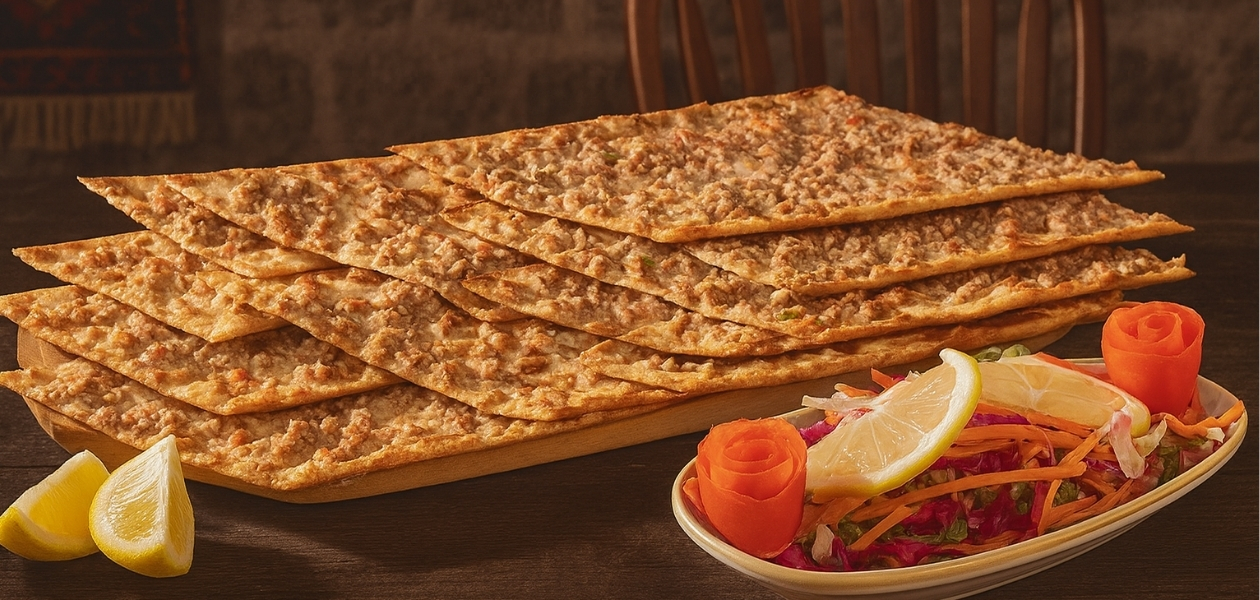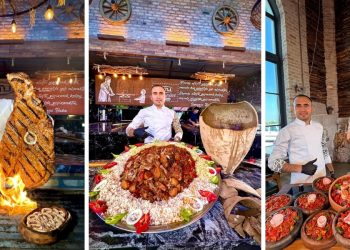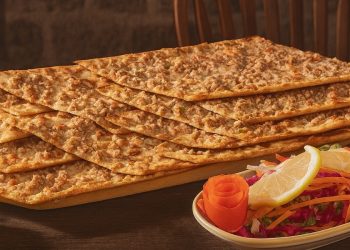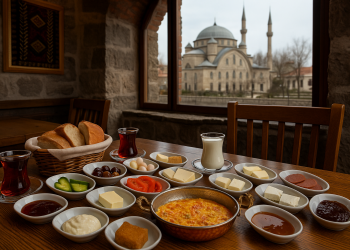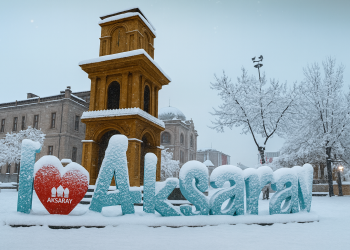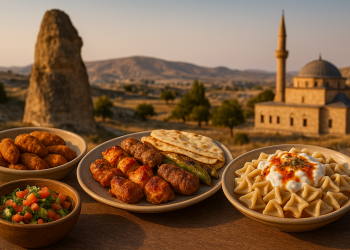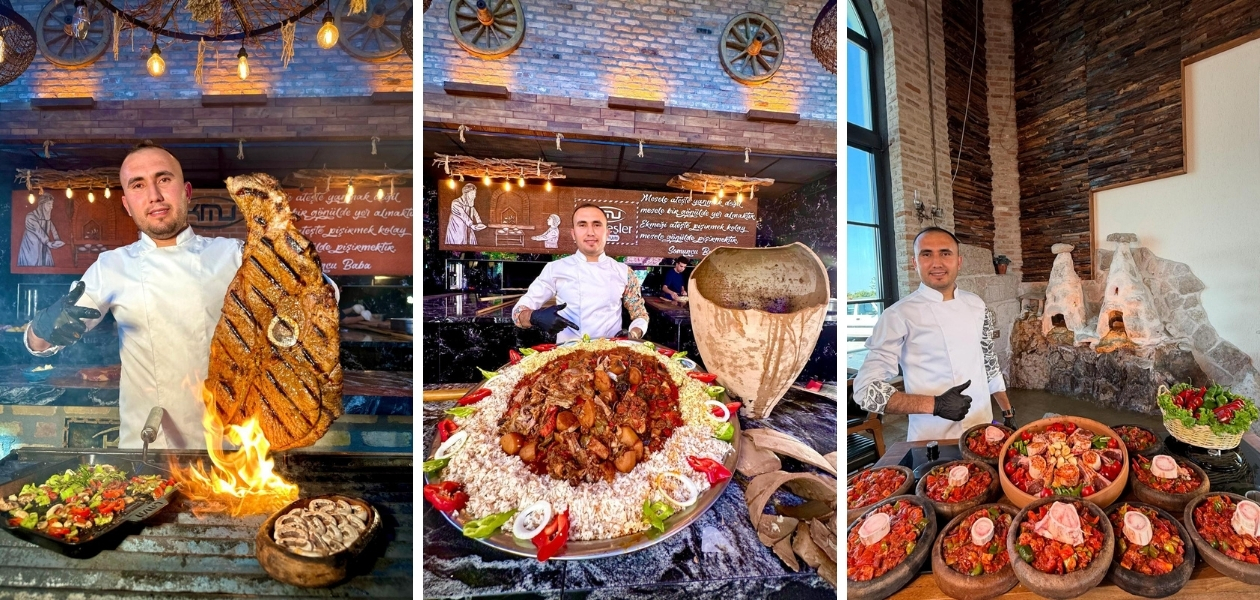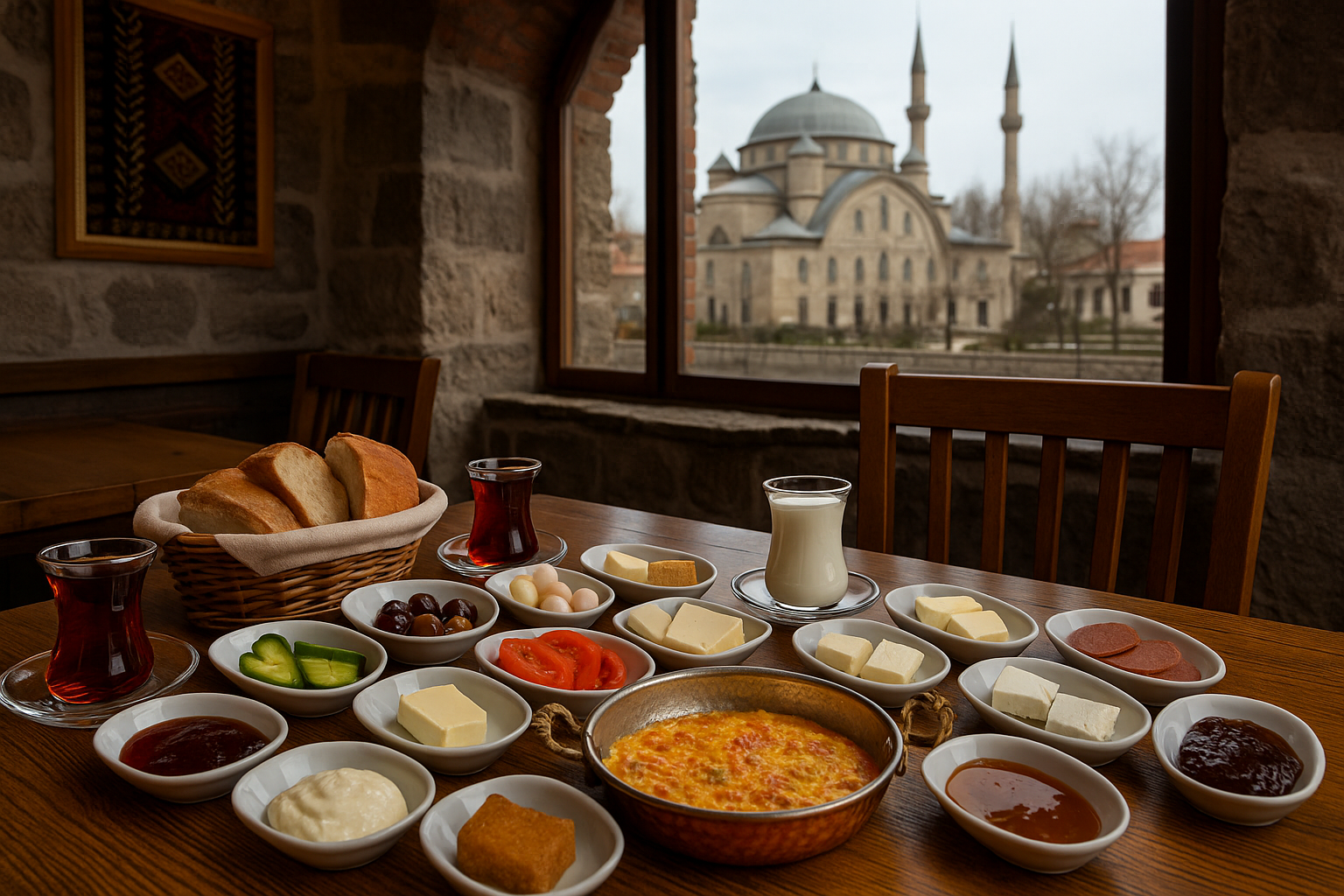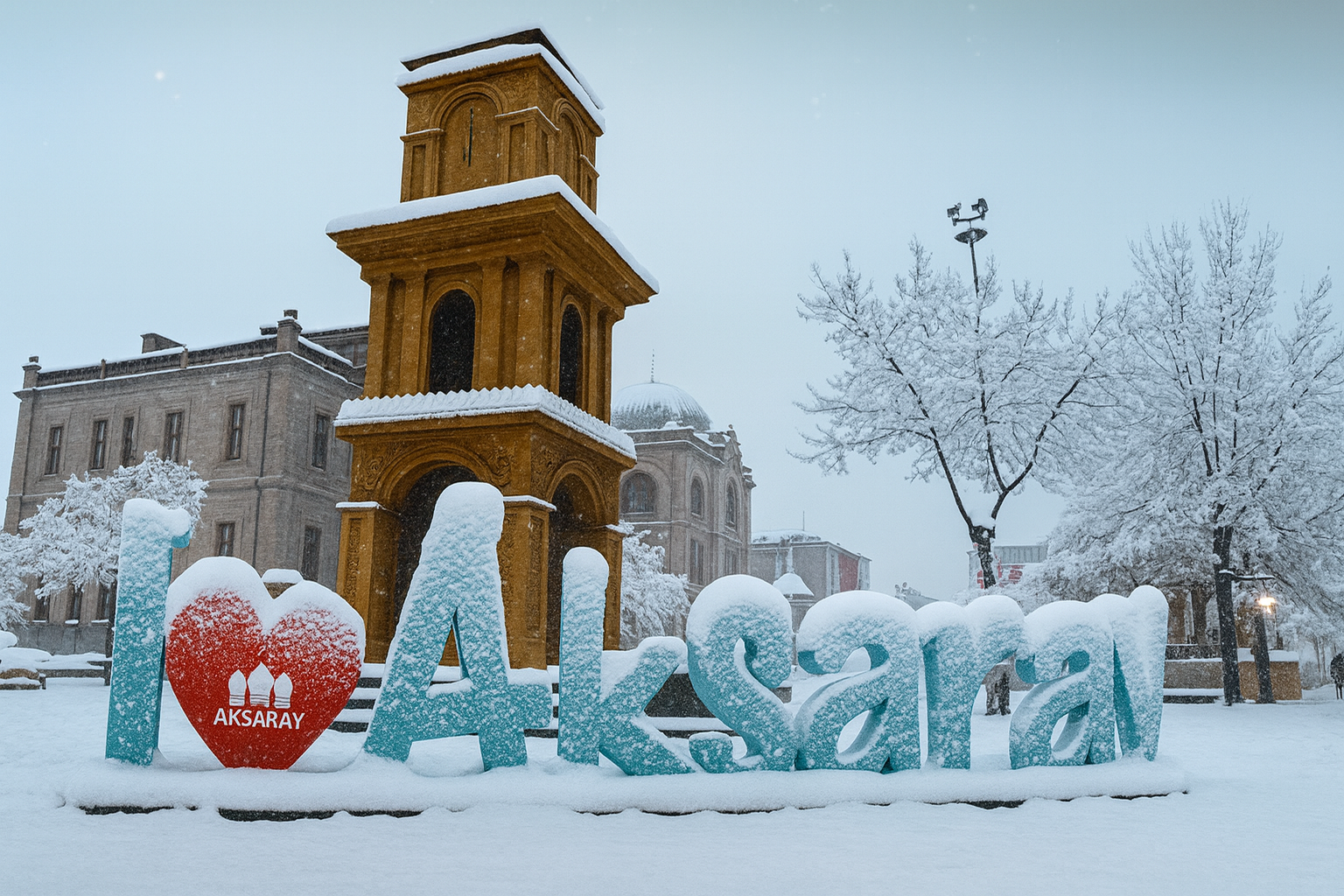Aksaray, which holds a special place on Turkey’s gastronomic map, is renowned not only for its historical and cultural richness but also for its regional cuisine. One of the most beloved flavors of this rich culinary heritage is undoubtedly Aksaray meat bread. Although sometimes confused with the Konya style, Aksaray’s unique meat bread offers a distinctive culinary experience with its thin dough, flavorful meat, and baking technique. Baked in wood-fired stone ovens and shaped by skilled hands, this delicacy not only satisfies the appetite but also provides a traditional experience. The meat is carefully chopped without any gristle, the spices are used in just the right amount, and the dough has a crispy texture, which are the most distinctive features that set Aksaray meat bread apart from similar dishes.
Tasting this delicacy is like taking a short journey through the history, culture, and hospitality of Aksaray. An indispensable dish for both locals and domestic and foreign tourists visiting the city, it is a culinary heritage passed down from the past to the present. In this article, we invite you on a delightful journey filled with the story of Aksaray meat bread, its preparation stages, and tasting recommendations.
The Cultural Journey of Meat Bread: From Aksaray to Anatolia
It is known that Aksaray’s first name in history was “Kurşaura” and that this name meant “land of plates and tablets” in Hittite texts. This expression shows that the origins of pottery and table culture in the region date back to the 1600s BC. Similarly, kitchen utensils found in the Çatalhöyük excavations near Konya and 8,000-year-old bulgur, lentil, and pottery remains unearthed in neighboring provinces such as Aksaray, Karaman, Niğde, and Nevşehir clearly demonstrate that this region has a deep-rooted culinary tradition.
With the discovery of fire, cooking and consuming meat became a cultural habit, which over time became established in the region’s dining traditions. Products such as yogurt, ayran, and yufka, brought by the Turks from Central Asia to Anatolia, merged with the meat culture, thus giving rise to the primitive form of today’s meat bread.
In the 13th century, Ateşbaz-ı Veli, the head chef of the Konya Mevlevi Dergah, brought order to the kitchen and systematized recipes. The mention of meat bread in the works of Mevlânâ Celâleddîn-i Rûmî reinforces the historical importance of this delicacy. The saying, “Bread and meat come from the earth, eat in moderation so that you may remain on earth like the earth,” sheds light on both the philosophy and history of the dish.
The famous traveler Ibn Battuta also mentions in his 13th-century work that dishes such as meat bread were passed down from generation to generation through a master-apprentice relationship. At that time, this delicacy was baked in neighborhood bakeries, shared with neighbors, and offered to passersby. Etli ekmek was not just a dish, but also a symbol of social solidarity and cultural unity.
In Which Province Is Etli Ekmek Famous?
Etli ekmek is a unique dish that dates back centuries and reflects the richness of Anatolian cuisine. This satisfying recipe, which skillfully combines dough and meat, emerged as a reflection of both traditional flavors and daily nutritional needs. Considering that many civilizations have left their mark on Anatolia, it is no coincidence that meat bread originated in these lands.
The frequently asked question, “Which province is meat bread from?” has found clearer answers, especially with developments in the field of gastronomy. Indeed, Konya province has succeeded in obtaining a geographical indication for this special delicacy as one of the leading cities in meat bread. Thus, meat bread has become a symbol of Konya cuisine, the city’s most famous and prominent local dish.
However, meat bread is not limited to Konya. It is prepared with unique interpretations and enjoyed in many provinces, including Aksaray, Kastamonu, and Sivas. This delicacy, which varies according to the taste preferences of each region, continues to be celebrated across Turkey with its cultural diversity.
Where is Meat Bread Made Outside of Konya?
Meat bread is a traditional Anatolian delicacy synonymous with Konya and associated with this city. Konya’s meat bread has earned a significant place in Turkish cuisine thanks to its unique preparation and taste, and has been registered with a geographical indication. However, this delicacy is not limited to Konya; over time, it has spread to neighboring provinces and different regions of Turkey.
Today, meat bread is carefully prepared and enjoyed not only in Konya but also in many provinces such as Aksaray, Karaman, Sivas, Izmir, Bursa, Kastamonu, Istanbul, Nevşehir, and Afyon. As in all districts of Konya, this tradition is kept alive in places such as Aksaray Center, Ereğli, and Akşehir. Each region adds its own touch to meat bread with its own ingredient preferences and cooking techniques, thus creating a rich mosaic of flavors.
According to historical sources, one of the earliest names to commercially produce meat bread was Halil Usta, who came from Thessaloniki in 1923. In the 1930s and 1940s, many masters popularized this delicacy and made it famous. However, meat bread is not the product of a single person; it is the product of a culture, a geography. Today, meat bread is considered a shared heritage of the Central Anatolia Region, which includes Konya, Karaman, and Aksaray.
How Long is Meat Bread?
Meat bread is a traditional Anatolian dish that also stands out for its shape. Usually prepared in a long and thin form, this delicacy stands out both for its presentation and its filling qualities. According to standard measurements, the length of meat bread varies between 70 and 80 centimeters on average, while its width varies between 12 and 15 centimeters.
However, these measurements may vary in local bakeries or for special orders. Today, some businesses, especially for promotional purposes or for large groups, can prepare meat bread up to 100 to 150 centimeters long. Similarly, the width can also be increased to 20 to 25 centimeters. These measurements may vary depending on the amount of dough used, the size of the oven, and the serving method.
The fact that meat bread can be prepared so long and wide is one of its most striking features that sets it apart from other dough-based foods. The filling spread over the thinly rolled dough and the baking technique in a stone oven produce a unique result in terms of both texture and taste.
How Many Grams is a Slice of Meat Bread?
Meat bread is quite filling, both in terms of the dough and the filling. Although portion sizes may vary depending on the proportions of the ingredients used, there is generally a certain standard. One portion of meat bread is prepared on approximately 180 grams of dough, to which at least 100 grams of minced meat filling is added. Thus, the total weight after baking is around 280 grams.
Depending on personal preferences and how the chef prepares it, the amount of filling can vary between 100 and 150 grams. This affects both the weight and calorie content of the portion. Meat bread is usually served in slices because it is typically served in large portions. An average slice weighs approximately 70–90 grams.
These ratios may vary depending on whether it is homemade or bakery-style. However, when evaluated based on basic measurements, it can be safely said that meat bread provides a filling and nutritious meal.
What Meat is Used to Make Meat Bread? How is the Minced Meat Prepared?
One of the most important elements of meat bread is, of course, the meat used. Traditional recipes call for medium-fat lamb, mutton, beef brisket, or heifer meat (young female cattle that have not yet given birth). For the best results, meat from flavorful and tender cuts such as ribs and brisket is used. The meat’s flavor and texture directly affect the taste of meat bread.
These meats are minced using the shield technique between two blades, adhering to traditional methods. Mincing the meat by hand or with a knife preserves its fiber structure and enhances its flavor. For this reason, machine-minced meat is generally not preferred in meat bread making, as machine mince can negatively affect both the texture and aroma. Mastery in meat bread is crucial at every stage, from preparing the mince to spreading the dough.
Generally, 1 kilogram of boneless meat is sufficient to produce an average of 10 meat breads. Each portion can be filled with 100 to 150 grams of minced meat filling, depending on preference. This ratio determines both the filling and flavor balance.
What Kind of Flour Is Used to Make Meat Bread?
One of the most important factors determining the flavor of meat bread is undoubtedly the dough. The quality of the flour used is crucial for obtaining a thinly rolled, crispy, and durable dough. When preparing meat bread dough, high-quality white flour and brown flour (whole wheat flour) are usually mixed in certain proportions.
The most commonly used ratio is a 60% white flour and 40% brown flour mixture. This ratio balances the nutritional properties provided by brown flour with the flexibility and softness provided by white flour. However, these ratios may vary from city to city and from master to master. While equal mixtures are preferred in some regions, some recipes use 20% white flour and 80% whole wheat flour. The heavy use of whole wheat flour gives the bread a more fibrous and filling texture.
The elasticity of the dough, its ability to be rolled thinly, and its baking durability are directly related to the correct choice of flour mixture. Therefore, making meat bread is not just a recipe; it is also a traditional craft that requires knowledge of ingredients and skill.
How Many Calories Are in One Meat Bread?
Meat bread is a traditional Anatolian dish that stands out for both its taste and its filling properties. However, one of the frequently asked questions for those who pay attention to their nutrition is “How many calories are in one meat bread?” This value may vary depending on the size and content of the portion.
A standard meat bread contains approximately 250 to 300 calories. The accepted calorie amount for an average serving is approximately 277 calories. This value may vary depending on the amount of meat used, the thickness of the dough, and the cooking method.
In terms of nutritional values, 100 grams of meat bread contains:
- 11.59 grams of protein,
- 23.55 grams of carbohydrates,
- 7.25 grams of fat.
With this composition, meat bread is a balanced meal in terms of protein, carbohydrate, and fat balance. Meat bread, which is an energy-giving option especially for active individuals, can be compatible with a balanced diet when consumed with portion control.
How is Meat Bread Made?
Meat bread is a unique Anatolian delicacy that requires skill and is prepared using traditional methods. One of the most important stages of the production process is the baking method. Oak wood is generally preferred in traditional meat bread ovens. Oak wood provides both steady, high heat and a natural aroma to the food.
The oven baking technique is quite unique. The fire is placed on the right side of the oven; the meat breads to be baked are placed on the left side of the fire, in an area that is not directly exposed to the flames. This ensures slow and even baking. After being placed in the oven, the meat bread completes its first stage of cooking in about 4-5 minutes. It is then removed from the oven for a while to allow the filling to absorb the moisture and thicken.
Presentation is also part of the cultural value of this dish. Traditionally, the cooked meat bread is served on a wooden serving board. It is served with roasted peppers, parsley, and lemon slices on the side. These garnishes complement the flavor of the meat bread and leave a balanced taste on the palate.
What Goes Well with Meat Bread?
Although meat bread is a very filling and delicious main dish on its own, the complementary flavors added to it turn this regional dish into a feast. In traditional serving culture, meat bread is not just taken out of the oven and placed in front of you; it is served with carefully selected accompaniments.
According to historical sources, one of the most popular drinks served with meat bread in the past was ayran made from strained yogurt. In addition, refreshing drinks such as cranberry syrup were also served, especially in the summer months. This tradition continues today; cold ayran stands out as the drink that best complements meat bread.
Simple but effective garnishes are used in the presentation to enhance the flavor. Meat bread is usually served with:
- Roasted green peppers,
- Fresh parsley sprigs,
- Sliced lemon.
These garnishes provide balance on the palate and enrich the visual presentation of the dish. The slight sourness of the lemon balances the intense flavor of the meat bread, creating a refreshing taste profile.
What Goes Inside Meat Bread?
When we talk about meat bread, it’s not just about thin dough and minced meat; the secret to this delicacy lies in the careful selection of ingredients and adherence to the traditional recipe. The question “What is meat bread made of?” is frequently asked by those curious about the intricacies of this special dish.
The filling of meat bread is always based on high-quality, medium-fat minced meat. This minced meat is usually prepared from delicious and tender meats such as:
- lamb,
- beef brisket,
- heifer ribs,
- or mutton.
According to traditional methods, the meat is chopped between two knives called zırh. This method preserves the flavor of the minced meat without damaging its fibrous structure.
Other ingredients added to the filling besides the mince are:
- Dried onion (chopped),
- Green pepper,
- Tomato,
- And limited to just salt.
These ingredients complement the mince without overpowering its natural aroma. In particular, the use of spices is not preferred in traditional recipes, as too many spices can overshadow the pure flavor of the meat.
Once the filling is prepared, it is spread over specially kneaded thin dough and baked in a stone oven before being served. The thinness of the dough, the balance of the filling, and the baking method are the key elements that distinguish meat bread from similar dishes.
What are Meat Bread Masters called? What are their duties?
Meat bread is not just a dish; it is also a craft that requires teamwork. In traditional ovens, meat bread is made through the harmonious work of masters with different job descriptions. Each master forms a link in the process and is named according to this systematic division of labor. Meat bread masters generally take on the following four main roles:
- Tırnakçı
The dough shaper is the artisan responsible for the most demanding stages of meat bread preparation. Their task is to shape the rolled-out dough, spread the minced meat filling evenly over the dough, and ensure the meat bread is ready for baking. They also play a crucial role in determining the product’s quality by controlling the consistency and distribution of the filling.
- Scooper
The scooper is the master responsible for baking the meat bread. He places the prepared meat bread in the oven with a special oven scoop, carefully monitors the baking time, and turns it when necessary to ensure even baking. Issues such as oven temperature, wood placement, and baking time depend entirely on the scooper’s expertise.
- Dough Maker
The dough maker is the master who kneads the dough that forms the basis of the meat bread and divides it into portions to make it ready for use. The flour-to-water ratio, kneading time, and dough resting stages are entirely under the dough maker’s control. Quality dough directly affects the crispiness and carrying power of the meat bread.
- Slicer
The slicer is the artisan who slices the meat bread coming out of the oven to the desired size, places it on plates, and prepares it for serving. The slicer plays a major role in aesthetic presentation, portion control, and serving speed. Since meat bread is usually served on wooden plates in traditional service, this stage is also important in terms of visual presentation.
The Geographical Indication Journey of Meat Bread
Just as a business applies for a trademark and patent to protect its name and commercial identity and obtains official registration, regional dishes and foods with cultural value can also be included in the same scope of protection. In this context, the registration process for foods is carried out under the name of geographical indication, and in Turkey, this process is carried out by the Turkish Patent and Trademark Office.
Thanks to its historical origins, traditional production method, and regional connection, meat bread has been registered as a geographically indicated product of Konya. With this registration, all elements of the meat bread production process, such as the materials used, the preparation method, and the presentation style, have been officially defined and protected. This prevents the product from being imitated and ensures that the cultural heritage is preserved.
For a food product to obtain a geographical indication, it must meet certain criteria:
- It must have been known and recognized by the same name for at least 30 years,
- It must be produced using traditional methods or prepared using traditional presentation methods with modern techniques,
- The use of local raw materials and ingredients are among the fundamental conditions of this process.
Meat bread, as one of the rare products that meets all these conditions, has become a cultural symbol of the Konya cuisine and has secured an important place on Turkey’s geographical indication flavor map.

